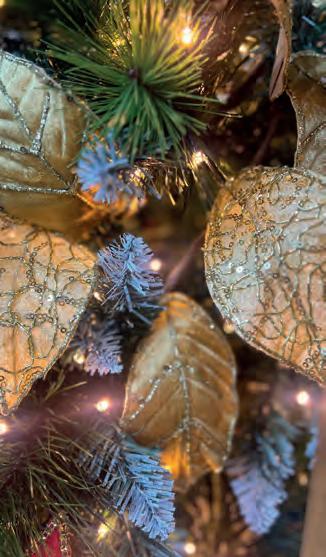









“Autumn is a second spring when every leaf is a flower” - Albert Camus
Millions of television viewers have been caught up in the transformation of the walled garden at Powderham Castle into a vibrant productive growing space. The work on upgrading the site has been led by BBC presenter Frances Tophill with the work being filmed for BBC’s Gardeners’ World. Frances has been spending time at Powderham with her friend Jeanette organising the planting, a project which has entranced viewers.
Powderham Castle is a fortified manor house on the banks of the River Exe and six miles south of Exeter. The manor is known for its beautiful surroundings and historic past as it was built in the 14th century by Sir Philip Courtenay.
The Gardeners’ World star has been transforming part of the walled garden by planting raspberries, fruit trees and climbing beans. Frances also added colour to an ornamental border and shared tips for growing herbs in containers. Powderham Estate, Exeter EX6 8JQ

The British Hedgehog Preservation Society has issued top tips on how to reduce the risk of harming hedgehogs this November.
They are asking people to remember hedgehogs and consider how actions can harm the wildlife living in our gardens and neighbourhoods.
“A bonfire pile looks like the perfect readymade home to a hedgehog seeking a safe and cosy winter nest to hibernate in. They don’t know we plan to set light to it!’ said a spokesman.
BHPS is asking us to ‘Stop, Move and Check’ this November:
There’s a new journey in store for visitors to the popular RHS Garden Rosemoor Glow illuminations over the festive season. It will mean the opportunity to see the spectacular lights at the north Devon garden as they have never been seen before.
The Rosemoor Glow, which has now become of the highlights in the gardens for the whole year, is open on selected dates between Friday, 15th November through to Saturday, 28th December.
For the first time, visitors will be able to venture through the Rock Gully, past a sparkling waterfall and into a rainbow tunnel of lights. Spot fantastic silhouettes lit up in the Stumpery and enjoy the warming glow of a ‘field of flames’ in Lady Anne’s Arboretum.
The visit also gives the chance to tuck into takeaway food and drink, including soups and pasties, festive treats and
Stop - do you need to have a bonfire this year? Can you attend a community event, or mark the occasion in a different, more wildlife-friendly way? The fewer bonfires there are, the fewer wildlife casualties there are too.
Move - if you do decide to have a bonfire, always build it on the day you plan to light it. Move all accumulated materials to a new site as hedgehogs and other wildlife or pets may be hiding inside.
Check - before lighting from one side, check the entire bonfire pile carefully for wildlife and pets. Shining a torch inside the pile, gently lift each section with a pole or broom. Never use a spade or fork as these can cause great harm. Listen for the huffing sound of a hedgehog which has been disturbed. Visit www.britishhedgehogs.org.uk
mulled wine or hot chocolate, from the Otter Café and Shepherd’s Hut along the route.
You can enjoy a seasonal meal in the Garden Restaurant before or after the trail walk. Buy a two-course Glow Simple Supper and receive a £5 voucher to use in the restaurant between Monday 6th January and Friday 31st January (no minimum spend; one voucher per transaction).
ROSEMOOR GLOW RUNS ON:
Fridays and Saturdays from 15th November to 7th December; then Thursday 12th to Saturday 14th December; Tuesday 17th to Saturday 21st December; Monday 23rd December; and Friday 27th to Saturday 28th December. The gardens open for Glow from 4.30pm to 8pm. Last entry 7pm.
Pre-booked tickets only: All visitors including members, guests of members and under fives require a pre-booked ticket. You may arrive at any time during your booked time slot and can stay as long as you like within opening times. Ticket details are available at www.rhs.org.uk/gardens/ rosemoor
Forestry England’s outdoor exhibition of Earth Photo shortlisted works returns to Haldon Forest Park in 2024.
The free exhibition will be open from Tuesday, 15th October until Wednesday, 19th March 2025. Step among towering trees to explore 30 of the 124 final shortlisted images by photographers from around the world, reflecting on issues affecting the climate and life on our planet. The exhibition is located outdoors 100 metres from the car park, on a 0.5km wheelchair and pushchair accessible trail. It is suitable for all-terrain mobility scooters. Enjoy the exhibition walk by itself, or as part of a longer walk. Entrance is free.
Haldon Forest Park, Kennford EX6 7XR
There’s still time to join the seasonal apple celebrations at NT Killerton where apple and cider production has left a legacy of heritage orchards. Visitors can follow a special trail to the orchards to harvest apples for traditional cider or pick your own to take home. The trail is open until Sunday 3rd November.
NT Killerton, Broadclyst, Exeter EX5 3LE

You can enjoy the magic of Christmas with a special craft and food fair in the build up to Christmas, filled to the brim with temptations and delights. Included with garden admission; free to RHS members. After 4.30pm, admission is included with Glow tickets ad runs until 7pm. On Sundays the opening times are 10am-4pm.
The fair is open: Friday 15th to Sunday 17th November; Friday 22nd to Sunday 24th November; and Saturday 30th November to Sunday 1st December.

The magic of the Pumpkin Festival is spilling over into November at Pennywell Farm near Dartington which runs through to Sunday, 3rd November. There’s access to the pumpkin patch, a fun pumpkin trail and such extras as marshmallow toasting and a scarecrow dressing up competition. Day tickets cost £21.95 and children three to 15 years £17.95.
Pennywell Farm TQ11 0LT www.pennywellfarm.co.uk/pumpkin-patch

The fight for nature in our National Parks with emphasis on Dartmoor and Exmoor is the theme of the guest talk at Devon Wildlife Trust’s annual meeting on Tuesday, 19th November. It will be given by Dr Rose Neill, chief executive of the Campaign for National Parks who will be joined by Nick Bruce-White, chief executive of Devon Wildlife Trust.
The annual meeting is the chance for anyone interested to get an insight into the work and achievements of the trust. The online event is free and is available on Zoom from 6pm to 8pm but you will need to register in advance. www.devonwildlifetryst-org.zoom.us/meeting

Tim Richardson, the acclaimed author, journalist and founder of the Chelsea Fringe garden event which sits alongside the Chelsea Flower Show with a variety of events and displays across multiple locations in London, will be the guest speaker at the Devon Gardens Trust event on Thursday, 5th December at the Hartnoll Hotel, Bolham near Tiverton.
Tim’s books include The New English Garden and his latest book The English Landscape Garden: Dreaming of Arcadia is published at the end of October. The event from 11am to 4pm costs £43 for non-members and £38 for members. www.devongardenstrust.org.uk

Exmoor National Park is campaigning for visitors to get active when visiting the moorsthat means ditching cars, buses, bikes and even on horseback. Active travel means using your own body to get around, instead of a car or bus, on foot, on a bicycle, using a wheelchair or even on horseback.
It’s called active travel and can offer the health benefits of more exercise and reduce traffic and pollution.
The idea is to improve the infrastructure for Exmoor and will be the basis of future funding.
Access and Recreation Manager for Exmoor National Park, Dan Barnett said:
“We are interested in all kinds of journeys, whether going to school, the shops or the doctors, or visiting a popular spot to enjoy some leisure time. People may want to think about roads, paths within villages or our public rights of way network. We can look at ideas within the National Park and routes to the park from nearby settlements.”
“We will report on our findings early next year and hope to have a collection of projects for which we can seek funding and make reality.”
The number of cases of Japanese knotweed needed to be professionally removed has doubled in the past year in the West Country. The invasive plant shows no signs of being able to be controlled by many homeowners says a new report. Specialist professional companies have been stretched to deal with a number of orders to remove the plant says a local authority report compiled by three local authorities. It says that garden owners leave the problem until it needs more drastic action when the costs of removal can be as high as £2,000. The local authority has the right to step in is the plant poses a threat to public safety Often herbicide treatment is used with heavy plant equipment. The report stresses that most home insurance policies don’t cover the cost of Japanese knotweed removal.
National Trust rangers and gardeners say they are preparing for a mixed bag of autumnal displays across gardens, parklands and woodlands due to the cool, wet conditions preceding the yearly spectacle.
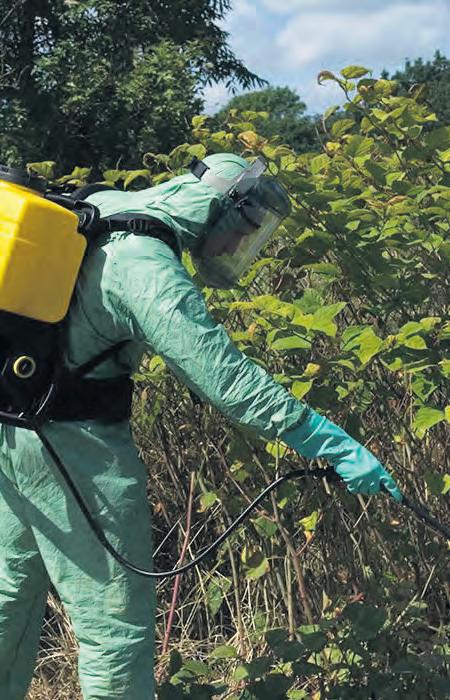

Following the wet spring, with higher-than-average rainfall and a cooler than average summer helping to sustain trees, the trust hopes for a dazzling colour display as trees have been able to hang on to their leaves for longer. However, tree crowns remaining at ‘full sail’ also increases the threat of damage caused by autumn storms, and the year’s weather conditions are also proving troubling for traditional autumn vegetable harvests.
Now, after an unsettled start to the season, the conservation charity is watching the weather closely to see how autumn colour might unfold and which seasonal delights visitors can look forward to.
Mike Beeston, National Trust Gardens and Parks head for the south west said: “‘Predicting what kind of autumn colour we will get depends on a range of factors, from temperature, sunlight, the degree of storm activity and how much the trees are under stress. We are so lucky to experience the seasons as we do in this country and seeing these wonderful colours with a clear blue sky is spectacular, so don the wellies and woolly hats, kick through some fallen leaves and enjoy the season while we can.”
For autumn colour at a National Trust property near you visit www.nationaltrust.org.uk/visit



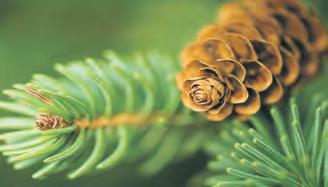

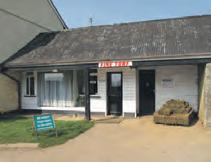
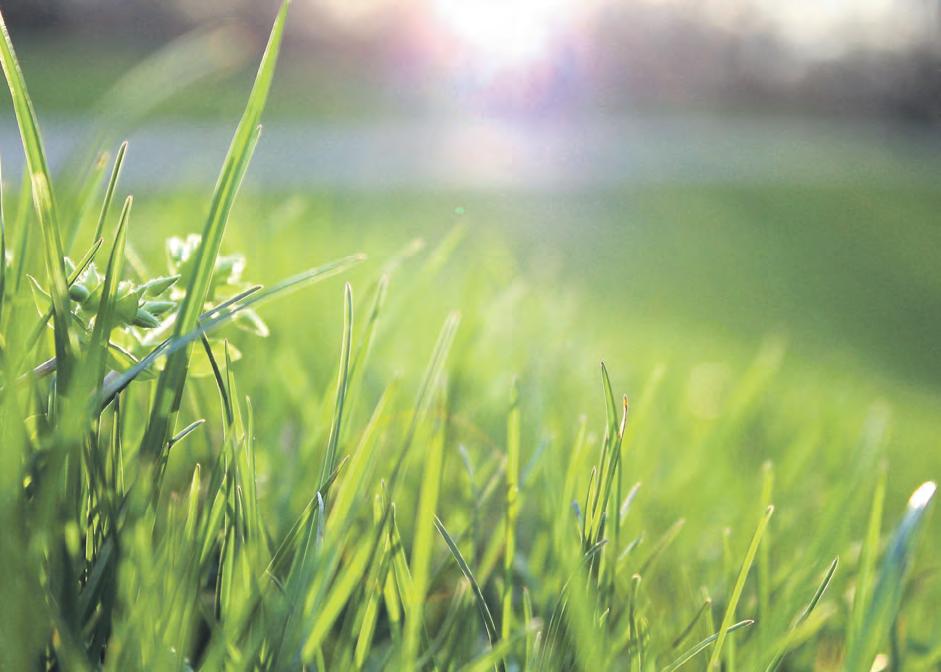




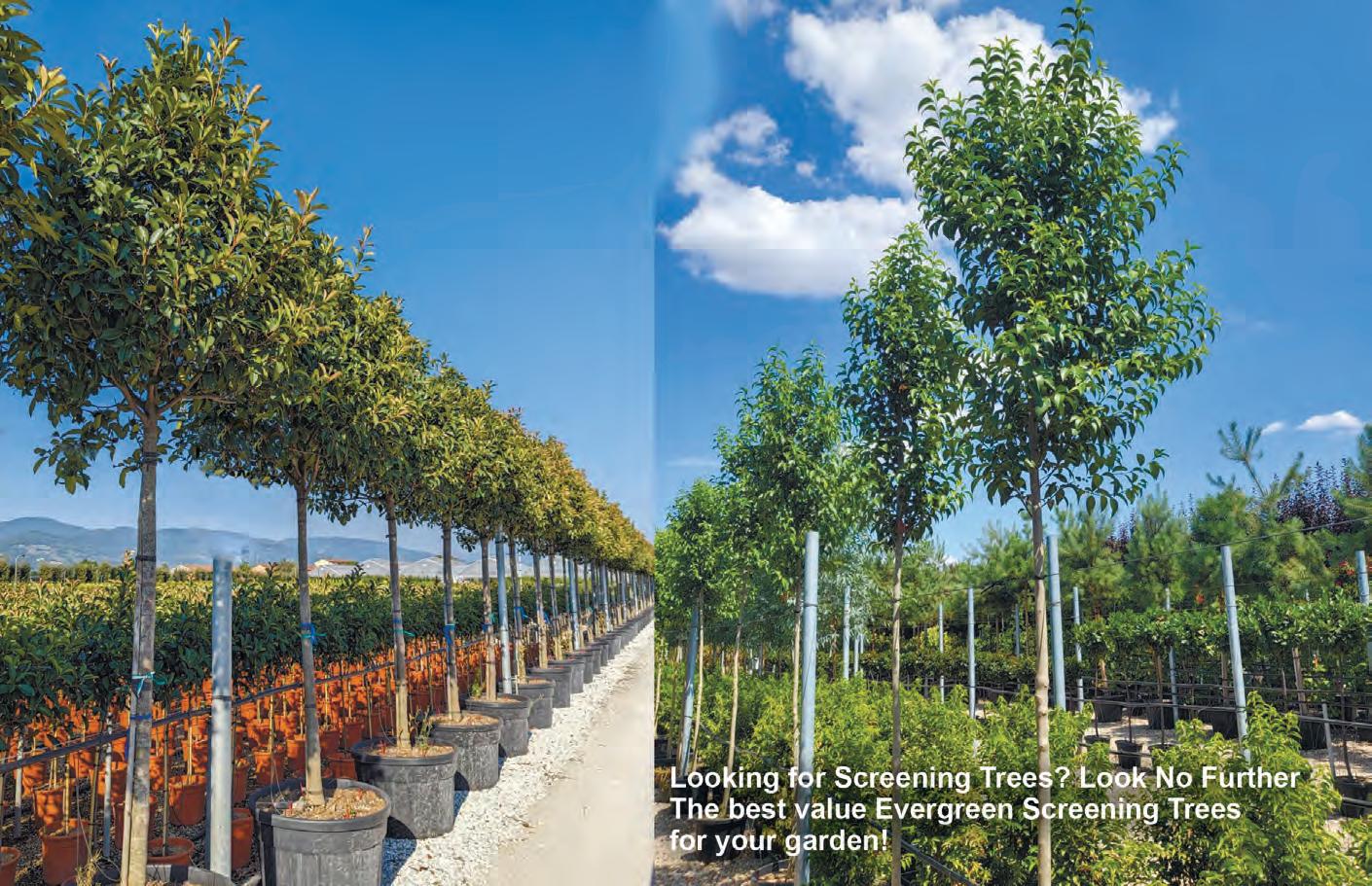

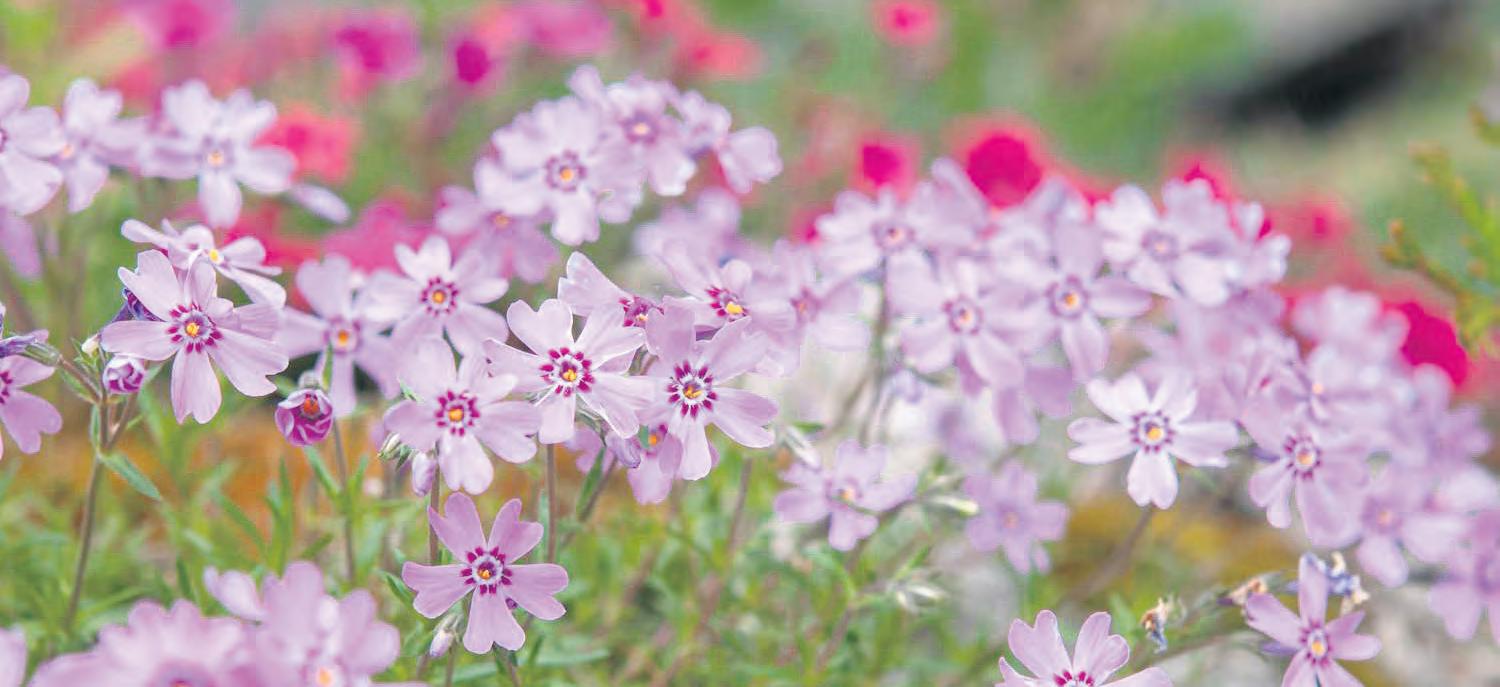
You can cheer up the darker days of winter by planning for a burst of spring colour in your garden in a few months’ time, putting together an explosion of floral options
Nothing is as uplifting as a flowering garden in the spring. As we head at a remarkable rate into the short, darker, colder days of winter there will be days when it can feel like it’s going to be forever before spring arrives and colour returns to the garden. If you need a dose of colour and flowers to brighten up those dull winter days, here are a few ideas for spring-flowering plants and bulbs to fill pots and borders.
It will all be designed to make spring something even more of a time to long for.
You can find a garden verbena for almost any sunny spot in the garden. Low-growing varieties make good ground cover, while hanging baskets can decorate the porch and the taller verbenas show off in borders. Their long bloom season lasts from spring until autumn.
From spring to autumn, pentas flowers like crazy, bringing large numbers of butterflies into your garden. The scarlet or pink flowers with pink centres are irresistible to them. Plant them in full sun and deadhead spent flowers to encourage more blooms.
Lupins are sun-lovers, so give them a warm, open, bright position. They also like well-drained or even poor soil that is slightly acidic. Lupins are a cottage-garden favourite, offering height and colour to the middle of a border in late April and May. They bear impressive, pea-like flowers, which are loved by bumblebees. They make a perfect cut flower. Avoid planting them in containers as they grow much better in the ground.

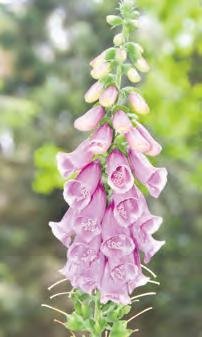
Foxgloves (genus Digitalis) are popular in cottagegarden planting schemes and loved for their spires of bellshaped, bee-friendly tubular flowers. Most foxgloves are biennial, which means they put on root and foliage growth in year one, and then flower and set seed in year two, before dying. However, some varieties of foxglove are short-lived perennials.
Digitalis purpurea is native to the UK. Its purple, pink, red or occasionally white bell flowers with spotted throats are a familiar sight in woodland clearings, heathland and gardens, where they bloom from May.
Foxglove is toxic, so keep it away from children and pets.
All pansies are violas but not all violas are pansies. The two words have become virtually interchangeable, but even though these plants share common origin, most large-flowering pansies are hybrids. Violas are a compact version of pansies.
Both pansies and violas come in a variety of colours ranging from white to blue, red, orange, yellow, and purple. These small, compact annuals provide sporadic colour in the winter months and then form a carpet of blooms in the spring. Pansies are great for containers and will grow in standard potting soil.
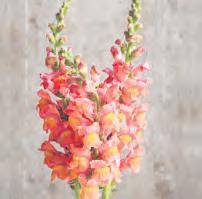
Snapdragons are great flowers for sunny spring borders, growing anything from six inches to three feet. Medium and tall snapdragons work well in the middle or back of a border underplanted with pansies.
These hardy, old-fashioned biennials or short-lived perennials in the carnation family are often grown as annuals. Each spring, dense clusters of fragrant white, pink, rose, purple, or bicolored flowers appear. The blooms look like small clouds on top of tall stems. Sweet William thrives in loamy, neutral or slightly alkaline soil in sun or in partial shade in hot summer climates.
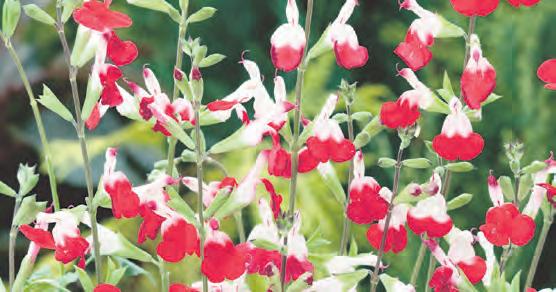
Salvia is a huge genus of plants that includes annuals like scarlet sage and perennials like Russian sage; most start to bloom in spring. The flowers bloom in gorgeous shades from fire-engine red to pink, pale lavender, and blue. The leaves often have a medicinal scent. Salvias are ideal for a coastal garden.
This native, ground-hugging phlox transforms into a bright carpet of flowers each spring. Also known as moss phlox, it prefers moist but well-drained, organically rich soil and lots of sunlight. It can take some dappled shade in the afternoon in hot climates. Plant creeping phlox in rock gardens, along walls, and around garden edges.
Columbine is a family of mostly woodland wildflowers that are perennial in many areas. Many hybrids exist today in a wide range of showy colours. Most columbine does well in part sun or dappled sunlight. Deadhead columbine to prolong its bloom, extending their arrival in spring to late summer.
As soon as the weather warms in spring, every garden centre is decked out with the prolific blooms of impatiens. There are varieties for sun and light shade (common impatiens), so you can enjoy their bright colours in every area of the garden from spring onwards. All impatiens prefer well-drained, moist, organically rich soil, which makes them ideal for growing in containers.
Despite the name, wallflower is a real show-off in the spring garden. The name comes from the plants’ ability to grow out of cracks in walls. Wallflower shines best when planted in well-drained, average or sandy soil in full sun. It doesn’t like heat and is usually treated as a springtime annual.
Christmas at National Trust properties throughout the Cotswolds and the west country is now a major event offering visitors family trails, decorations, lights and many other themes in November and December
Winter Lights return to Knightshayes! Explore the formal garden at the National Trust property near Tiverton and see the house lit up on selected dates in December. Winter Lights run from 4pm until 7pm on Fridays, Saturdays and Sundays between Friday 29th November and Saturday 22nd December.
The ground floor of the house is also open and lit up with Christmas lights. See the sparkling Christmas tree in the Great Hall, watch the train set in the Drawing Room and hear Victorian ghost stories in the Billiard Room.


Knightshayes, Bolham, Tiverton, Devon EX16 7RQ

From Saturday16th November 2024 until Saturday 5th January visitors can hop on a Christmas journey and discover the house brimming with bright Christmas colours, sparkling lights and charming festive scenes.
The garden will be the backdrop for beautifully decorated trees with twinkling lights and classic Christmas colours. It will be a family adventure with games and activities in the gardens.
Hinton Ampner, Alresford, Hampshire SO24 0LA
Christmas at Stourhead in Wiltshire will run from Friday 29th November to Wednesday 1st January, with a trail approximately one mile long, taking around 90 minutes, walking at a regular pace through the wonderful grounds.
Killerton near Exeter will be immersed in festive cheer, with fairy lights and garlands filling the house and stable block. Festive family fun will be on offer in the outdoor trail, taking you through the gardens and Chapel grounds.. The trees will be displayed from Saturday 30th November.
Killerton, Broadclyst, Exeter, Devon EX5 3LE

Tickets are allocated by staggered trail start times and digital or printed tickets are accepted.Food and drink are available onsite and can be found at the beginning and end of the trail, with additional refreshments also available. Separate charges apply for all food and drink. Guide dogs and registered assistance dogs are very welcome at this event, but no other dogs can be admitted.
Stourhead, Stourton, Warminster, Wiltshire BA12 6QF

The Abbey grounds, courtyard, cloister and Great Hall will be in a seasonal mood every day from Saturday 23rd November (except Christmas Day, Boxing Day and New Year’s Day). There’ll be storytime with Mother Christmas in the servant’s hall, transformed into a cosy Christmas grotto for 2024, visits to Father Christmas who parks his sleigh in the courtyard, willow reindeer and a 20ft Christmas tree with more trees and lights in every corner, and The Great Hall re-opens for the Christmas period from Sunday 23rd November until Tuesday 31st December (closed Christmas Day and Boxing Day) with traditional decorations and an impressive tree, while the rest of the house is closed for the annual deep clean.
Lacock Abbey, near Chippenham, Wiltshire SN15 2LG

A ‘Nutcracker Christmas’ at Mottisfont runs from Saturday 23rd November until Sunday 5th January (closed Christmas Eve and Christmas Day). Enter the magical world of theatre as Mottisfont unveils The Nutcracker. Collect your ticket at the ‘Box Office’ then follow the story through rooms filled with sparkling trees, music and special light effects. Snowflakes swirl in a frosty wonderland, sugarplum fairies twirl in the Land of Sweets, and there’s a thrilling duel scene between the Prince and the Mouse King.
Outside, the adventure continues with The Nutcracker family trail, with activities, games and challenges to complete.
Mottisfont, Nr Romsey, Hampshire SO51 0LP
This year, Tyntesfield will transport you to a ‘Christmas Past’ with decorations in the house that take inspiration from each room, reflecting how the rooms were used by those that called Tyntesfield their home, starting from Monday 2nd December until New Year’s Eve, Wednesday 31st December. New this year is a carousel in front of the house, and a Dickensian street scene in the chapel courtyard, along with familiar favourites including chapel concerts, Christmas trails and craft workshops.
Decorations will feature a combination of inventive community sourced art installations which are being developed in partnership with SuperCulture, in collaboration with five local community groups. Other creative displays are being masterminded by the collections team, the gardens and outdoors team and volunteers. Outside, the aviary will be decorated using inspiration from winter scenes, and large sculptural trees will fill the orangery
Tyntesfield, Wraxall, Bristol BS48 1NX

Agatha Christie’s holiday home in Devon will be decorated in vintage Christmas style. Take part in a festive wreath trail inspired by songs around the garden - ‘Rock around the Christmas wreath’, a fun festive trail around the garden which will be open at weekends before Christmas from 11am until 4pm each Saturday and Sunday, starting Saturday 23rd November, and then the property will open daily from 27th until 31st December. Greenway, Greenway Road, Galmpton, near Brixham TQ5 0ES
Visitors can discover Christmas past in the house at Dyrham Park when it will be dressed with festive decorations from seven different eras from Tudor times right up to the 20th century. New this year will be a 1980s room filled with colour, fun and authentic items from the decade of decadence.
There will be pear-themed decorations to tie in with Dyrham’s pear orchard, a large outdoor Christmas tree with many more inside, and the chance to take a festive selfie next to a giant wreath. Families can get active while following a reindeer discovery trail around the 270-acre site.
Local choirs will be singing carols and festive tunes on weekends in the run up to Christmas, in the village church of St Peter which is next to the estate. There will be choirs performing in the church on Saturdays and Sundays from Saturday 23rd November to Sunday 22nd December at 1pm.
Dyrham Park, Dyrham, Bath SN14 8HY
The house will be dressed to impress with each room themed on a Victorian Christmas carol, from ships sailing down the dining room table to sheep taking over the drawing room an exciting display awaits in every room.
Take part in a festive family activity trail around the gardens and grounds, snap a photo on the sleigh or explore the wider estate for a winter walk. Carriage rides, brass bands and choir performances will take place over themed weekends, as well as wreath making and gingerbread decorating workshops.
The popular Christmas open evenings are coming back on Thursdays 5th, 12th and 19th of December . Experience the house in a new light after opening hours. Father Christmas will return for three days on Saturday 21st, Sunday 22nd and Monday 23rd December, between 11.30am and 3pm each day and slots to see him can be booked at the National Trust website.
Arlington Court, Arlington, near Barnstaple, Devon EX31 4LP
See the castle decorated for a country Christmas, inspired by family memories of the festive season at the castle. Wander around the house and enjoy the decorated trees and natural garlands, created from plants from the gardens by Dunster’s garden team. You can settle down and play games in the Morning Room, dress up in the Hat Room and spot friendly knitted robins hiding in the rooms. The castle is open from 10am to 4pm at weekends throughout December and daily from Saturday 21st December until Sunday 5th January, apart from Christmas Eve and Christmas Day. Last entry at 2.45pm each open day. And you can experience Dunster Castle after hours on Saturday 14th, Sunday 15th, Saturday 21st and Sunday 22nd December with an illuminated path leading up to the castle. After a leisurely stroll, explore the castle and savour seasonal treats in the Tenants’ Hall; the last entry to the castle is at 5.45pm. Dunster Castle, near Minehead, Somerset TA24 6NY
ACROSS
1. Levisticum officinale, a tasty herb (6)
4. Bassia scoparia or World’s Fair plant (6)
8. Thick layer of ice that covers an area of land (6)
13. Musician who plays the vibraphone (6)
14. A family of liverworts in the Marchantiales order (14)
16. Ring a Ring O’ Roses is an example of this? (7, 5)
17. Outermost layer of pericarps, as the rinds of certain fruits (7)
9. Black substance obtained by burning wood without much air (8)
10. He chooses very carefully from his fruit crop? (6,6)
11. An official statement issued to the media giving information on a specific topic (5,7)
12. British engineer (1803-59) famous for his rocket (10)
15. A fire-breathing dragon in heraldry (6)
20. Highwaymen without horses (8)
21. A wild mustard with yellow flowers (8)
24. An old-fashioned train system now popular with tourists (5,7)


For more details of events at these and other National Trust properties go to www.nationaltrust.org.uk and follow the links
18. According to Baroness Orczy, ‘... that damned _______ Pimpernel’ (7)
19. A certain fruit covered in a sugar candy coating? (6, 5)
22. Having spiny or prickly growths (12)
23. A unit of land in the Imperial system (4)
27. Campanula trachelium, a bellflower (10)
29. The quality of being soft and able to hold water easily (10)
31. A champion on Wimbledon grass (4)
32. Common name of plants in the Doronicum genus (8,4)
37. Common name of Kniphofia (3, 3, 5)
38. Mexican perennial plants with tuberous roots (7)
40. Embraces (archaic.) (8)
41. Equisetum hyemale (8,4)
43. Fruits of Vaccinium myrtillus (14)
44. Express great regret or disappointment (6)
45. People who always support others’ opinions (6)
46. A field with grass and wild flowers (7)
47. The most lazy or indolent (6)
DOWN
1. Aromatic plant of the mint family (8)
2. Genus of flowering plants in the moschatel family (8)
3. Family of flowering plants named after Swiss naturalist Gessner (12)
5. Atriplex hortensis or mountain spinach (6)
6. Common name of American larch (10)
7. Another name of the Sictus tree (4)
25. Denoting plants of the orchid family (12)
26. Heracleum mantegazzianum, a tall perennial (5,7)
28. Common name of sedum acre (10)
30. Scientific name of Monterey Cypress tree (10)
33. Where a granite moorland is found in Cornwall (6)
34. Comic opera by Gilbert and Sullivan (8)
35. Strap-shaped as in leaves or flowers (8)
36. Alternative word for shallot (8)
39. A deciduous tree of the Nyssa genus (6)
42. Plant commonly called avens (4)
There’s a saying that the more time spend thinking about a Christmas present the more appreciated it will be. If that’s the case then there’s still plenty of time to find the right present for friends and family. Presents with a gardening theme are always well appreciated and we’ve a few ideas for you to think about.
Downstream Dorset, River Tales and Local History provides a colourful and inspiring exploration of Dorset with its many rivers and riverside towns and villages. It makes an ideal Christmas gift for anyone who loves or knows Dorset.
You may be surprised by some lesser-known tales and gems from Dorset’s rich history!
Mary van Coller has travelled the county, exploring riverside communities and taking photographs, before being published by Spiral Publishing Ltd and Country Books.
It’s just £22.95 +p&p from www.downstreamdorset.co.uk or www.spiral-books.com
20% of all proceeds is donated to the Dorset and Somerset Air Ambulance.
High quality courses in organic vegetable growing sound like a different and exciting Christmas present. They are on offer from Down to Earth, a Cotswold’s community supported agricultural scheme based in Sheepscombe which works alongside Local Community Market Gardens to provide locally grown food to organic standards.
LCMG believes everyone can and should have access to fresh, locally grown and seasonal food at affordable prices and for just £15 members enjoy seasonal vegetables straight from the garden.
The project has two new organic growing vegetable courses next year with weekly courses - entry level and intermediate.
On the entry level course you will learn about a range of organic growing techniques, soil management including a range of growing options including no dig, making compost and using mulches and feeds.
On the intermediate course attendees will be given their own area of land to develop from scratch and see crops from each food through from seed and sowing through to harvesting.
Tools and equipment will be provided on both courses. Booking is essential as spaces are limited. The courses are based on land lying to the south of the Old Farm House, Beeches lane, Sheepscombe, Stroud GL6 7QZ.
Email: info@downtoearthstroud.co.uk Tel: 01453 700011 www.facebook.com/dtestroud

new growers interested in the practical aspects of growing organically.
• Organic Food Production Intermediate Level - learn and consolidate your organic growing practices for yourself or for a career in horticulture. For more information please contact us on 01453 700011 or info@lcmgstroud.co.uk WHY NOT GIFT A COURSE FOR



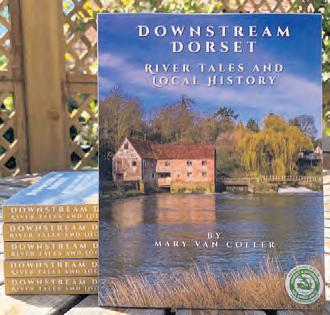

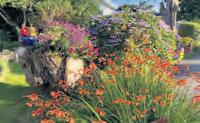










The festive highlight at RHS Garden Rosemoor is again the RHS Glow illuminations which transform the landscape into a dazzling winter wonderland.
Visitors will be able to explore the garden and make memories on an after-dark trail of kaleidoscopic light and colour. For the first time, the route with light and sound installations reaches the arboretum where you can admire a carpet of colour and harlequin trees. You are advised to book early to secure your preferred time on selected dates between Friday, 15th November – through to Saturday, 28th December.
If you prefer to make the most of the daylight hours then visit the north Devon garden between Monday, 9th November and Friday, 31 January to admire the work of 40 sculptors from across the UK, including local artists from the West Country. See over 200 sculptures, ranging from fluid installations to thought-provoking, large-scale pieces, set against the architectural textures and subtle tones of winter.
If you like to plan ahead, you can even combine your visit with some retail therapy. Steal a march on your Christmas shopping at the Magic of Christmas Craft and Food Fairs, with tasty temptations and crafty delights Friday to Sunday 15th to 17th and 22nd to 24th November and Saturday 30th November to Sunday 1st December, (admission after 4.30pm included with Glow tickets on selected dates). You can pick out a UK grown Christmas tree, buy decorations and find gifts for the bookworm in your life from the garden centre or enjoy an evening of traditional carols with a mince pie and mulled wine with The Exmoor Carollers at the Victorian Christmas Carol Concert,which is at 4pm on Sunday, 15th December. RHS Garden Rosemoor, Torrington EX38 8PH

Boscrege Caravan and Touring park in Cornwall is a peaceful and picturesque park, set at the foot of Tregonning Hill, Godolphin National Trust and amongst tranquil Cornish lanes in an area of outstanding natural beauty. The park, open all year is close to the Cornwall coast and a few minutes’ drive to Praa Sands, one of Britain’s nicest beaches. So, if you are looking to take a luxury holiday (doggie friendly with dog friendly homes and on-site designated fields for the dogs too) in Cornwall in a either a self-catering caravan, lodges touring or even purchasing your own holiday home then contact Boscrege Caravan and Touring Park.
Boscrege Caravan Park, Boscrege, Ashton, Cornwall TR13 9TG Tel: 01736 762231 www.caravanparkcornwall.com
Christmas is coming and what better gift than the National Garden Scheme Garden Visitor’s Handbook 2025 - the essential guide to over 3,500 gardens opening next year. With detailed descriptions of every garden, stunning photos, and handy maps and calendars, all the information you could possibly need to visit a beautiful garden is right at your fingertips! Price £14.99p .Or browse our shop for natureinspired Christmas cards designed exclusively for the National Garden Scheme by printmaker Lisé Jolly, and beautiful gifts inspired by our gardens and nature. Every purchase in aid of the National Garden Scheme and the vital nursing and health charities we support.
Visit our online shop: www.ngs.org.uk/shop

The garden undergoes a lot of change in November, as its colours begin to fade, and it becomes a little less productive than it was in late summer. It is often a chilly month when winter feels very much just around the corner. Frosts have done their work and most plants are resting. This is the month to plant your tulip bulbs for flowering in spring.
If you’re busy cutting back and tidying borders this month, add your waste material from the garden to your compost heap or bin. You could also use the collected leaves to make leaf mould; place them in a reusable bin bag with a few puncture holes and leave them to decompose for up to two years. Use this month as an opportunity to plant bare-root trees shrubs and roses and to clean or repurpose any pots, trays or troughs you don’t plan on using to help with the organising of the shed in preparation for the busy spring months that are just around the corner.
Most of all, don’t forget to stop and enjoy the autumn colours and foliage now as it can be truly spectacular!
1
Winter salads, such as ‘Grenoble Red’ lettuce, mustards and corn salad, all produce much better crops of leaves if they’re protected during winter. Fleece might seem the obvious choice, but it rips easily in windy weather, so you may prefer to use insect-proof mesh held up in a low curve by wire hoops. You shouldn’t need to water at this time of year, but keep an eye out for slugs, which like to nibble the leaves.
3
Still time to go out seed collecting
There will still be time to harvest your own seed.
It is fun and very cost effective, but it takes a little understanding and planning.
Seedheads can ripen quickly, and must be watched carefully in order to collect the seed before they are dispersed.
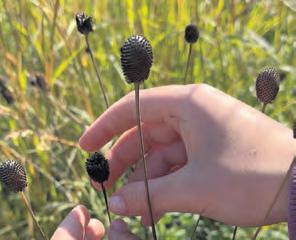
As a rough guide, seed is set about two months after flowering.
Some seed is collected when well-developed but immature and green, such as Anemone nemorosa, calendula and Ranunculus.
The plants from which you collect seed must be healthy and vigorous. This will help ensure good quality.
Usually only species “come true” from seed – seedlings from a hybrid will be extremely variable.
Most seed germinates best if sown as soon as it ripens, whereas seed harvested while immature will not germinate.
5
A must do November job is to sow broad beans in deep module trays, with the aim of seedlings being about five cm high by the new year. This small size makes them more weather hardy than larger plants. The reason for the deep module tray is that broad beans quickly put out a long root. Sow in a greenhouse until mid-November and then the plants can go out before or even after Christmas. Sowing them in autumn rather than February means you should have an earlier crop. If the winter is very hard and the autumn-sown plants fail, you can always sow more in February. Remember not to sow too many seeds, as broad beans plants are multi-stemmed and give lots of pods.
2
If you are tidy-minded, it might go against the grain to leave the perennials standing, but in a month’s time you will find that certain plants have made fine winter skeletons and can be left until February or March. Fennel and miscanthus, verbena and teasel make good hibernacula for beneficial insects and their seed keeps the birds going in the cold periods as well as providing winter interest. It really does make a great deal of difference to the garden.
4

You must turn your compost heap
It is important to try and turn your compost heap once in the winter. It’s hard work but makes a worthwhile difference as it speeds up decomposition. It only needs to be done once and is a way of introducing oxygen to the heap. This feeds the bacteria, which promotes further decomposition. It’s also a good opportunity to break up any lumps you find and mix the ingredients. The easiest way to do it is to dig out the whole heap with a fork and move it into an empty neighbouring bin.



6
Garlic likes a period of cold so November is the perfect time to plant it for a heavy crop next year.
This easy-grow crop needs a cold winter period in the soil for the individual cloves to develop clusters that will turn into bumper bulbs come next summer.
Autumn planted garlic is always bigger and better than that planted in the spring.

Garlic will grow in the poorest of soils as long as it is free draining. If you have heavy clay soil, plant into small pots and then re-plant into the garden in the spring. Plant directly into soil.
Using a cane or spring, mark out a planting row, then push individual cloves into the soil, so the tips are five cms below the surface and space them 15-20cm apart. Cloves can rot off in waterlogged clay soil over winter, but don’t let this stop you. If you have clay soil, plant cloves in small pots, filled with good quality compost.
As you clear summer crops on the vegetable patch, increase the bed’s fertility for veg by mulching with organic matter, such as garden compost or spent mushroom compost. Apply a five cm-deep layer and leave the worms to drag it into the soil. 7
The period between early November and the end of the year is the best time to take hardwood cuttings. As soon as the leaves have fallen, take cuttings at pencil length and pencil thickness. Make a clean cut immediately below a bud and a sloping cut above to tell top from bottom. Plunge to half their depth in compost or a trench in open ground if you don’t have a frame. Vines, cornus, willow, buddleia and fig will be rooted by spring and ready for potting by mid-summer. 9

By November, the weather should be cold enough for the lawn not to need regular cutting, although it usually needs an occasional tidy-up during winter. Clean the underside by scraping off dried clippings and make sure the collecting bag is empty. If it’s a petrol mower, drain off the fuel, as unleaded petrol doesn’t store well. 8

Boost spring soil with a green manure

If you want to improve the texture and soil conditions for future vegetable crops then green manure is an increasingly popular option which can be grown over winter and then cut down and dug in during spring. They also keep weeds at bay over the winter. The popularity of green manure has meant there is a wide choice on the market, most are very easy to grow and it’s not too late to still sow in November if the local weather conditions are still favourable.

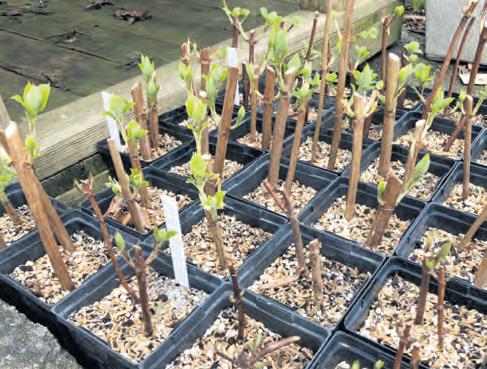
Sometimes when you have a gardening project planned it takes something out of the ordinary to give you some impetus.
Mine was a hospital visit.
For several years I had promised myself I would get to grips with propagating a load of hardwood plants and shrubs from the garden. I read Alan Titchmarsh’s book on it and thought what a great autumn project. Year after year something came up, gathering leaves, general gardening tidy ups, running a taxi service for my family, painting the study - that sort of thing.
Then I had to have a small operation, nothing life threatening but one that put me in hospital for a few days and to be honest took longer than I expected to recover from. I decided to take a monthly unpaid leave from work to get it all sorted out.
It was then the idea about learning to propagate came into being.
• Prune your roses. Cut off most of the year’s growth and take out large woody stems.
• Cut peonies back to promote healthy growth next spring.
• Cut back and tidy borders and make a note of any changes, additions or divisions you wish to make next spring whilst the thought is fresh in your mind, as it’s hard to remember back to how it looked once spring comes around.
• Divide perennials that flower before midsummer’s day, such as oriental poppies, peonies and lupins, as well as spring-flowering hellebores, pulmonarias and Solomon’s seal. Dig up, divide and replant straight away. Perennials that flower after midsummer are best divided in the spring – that’s a good general rule.
• Check any newly planted shrubs or trees, as if there’s been a frost this can sometimes lift them from soil. Deadhead pansies/violas/primulas regularly to keep the flowers coming.
• Tie in long, loose shoots of climbers to prevent them being damaged in high winds.
• Clear and dispose of any diseased rose leaves – don’t add them to the compost heap. Some roses hang on to their leaves. If these are diseased, try to pick them off. It helps to reduce blackspot next season.
Simply taking hardwood cuttings is a brilliant way to grow new plants. You can do it from mid-autumn to midwinter when the plants are dormant - not growing. I chose November as the perfect month.
I’ve found propagating plants an exciting gardening skill. It allows me to grow new plants for free. It shows that life can continue and renew from difficult circumstances, which can be comforting to know.
I’m not an expert but I think I know what I am doing now and taking cuttings has become a part of my gardening calendar just as much as daffodils in spring and roses in June.
A good time to take hardwood cuttings is just after the leaves have fallen from the plant. At the latest, you want to do it before any buds appear in early spring. Avoid taking cuttings on extremely cold or frosty days, as this will reduce the chance of success.
Some woody plants tend to be propagated most successfully through hardwood

cuttings. These plants can form new roots from dormant, mature shoots.
Because it can be done into the winter, taking hardwood cuttings also gives a reason to get outside in the colder, quieter garden months.
Here’s how I go about it:
• Go to the plant you want to take hardwood cuttings from. Check that it has enough healthy, suitable stems and cuttings from this year’s growth, at least 15cm long and as wide as a pencil.
• The cutting itself will be made outdoors from the plant. You could then do the rest of this activity from a seated position, if you are putting the cuttings in a container.
• Each cutting should end up being around 15cm long and as wide as a pencil.
• To start, cut and remove the complete healthy stem from the plant. On a plant like dogwood, this could be as long as one metre. This will allow you to create four or five good sized cuttings from one stem.
• To make a single cutting, find a bud towards the top of the stem. Cut the stem at an angle just above this bud. Cutting at an angle allows water to run off the stem. If there are leaves or a soft tip above the bud, remove them.
• Next, make the bottom cut. Look for a bud around 15cm below the top cut you just made. Using your secateurs, cut below this bud. Cut in a straight line this time, not at an angle.
• Cutting above a bud at the top and below a bud at the bottom is important. New leaves and stems grow from the top bud and new roots grow from the bottom bud.
It’s as simple as that. I have taken cuttings of fuchsia, dogwoods, honeysuckle, willow, buddleia and forsythia. You have to be patient as the results can take weeks and weeks but don’t despair - it works and it’s a joyous feeling to create something new.

There’s another very autumnal feel to the queries from our Country Gardener readers this month - with the emphasis on pruning and autumn diseases. If you have a query you would like help with then email us at editorial@countrygardener.co.uk

What are the blisters on my pear tree? The tree is about nine years old and has been badly affected this year. Is there anything I can do over the winter to prevent them returning in the spring?
Maurice Renton Chepstow
The tree probably has been infected by pear blister mites which overwinter underneath the outer bud scales on pear trees. In spring, the mites emerge and penetrate developing foliage. They feed by sucking out the contents of the leaf cells and while doing so produce secretions that create small, discoloured blisters around where the mites are feeding. Remove affected leaves or shoots - if your tree has a light infestation, just removing the affected parts can stop the mite spreading across the tree. The good news is that the disease will not affect the health or cropping of the tree.
I have a very large rhododendron eight feet by eight feet that I would like to cut back severely after it blooms. Is that possible? It’s far too big for the space available and I no longer have the energy needed to wrap up such a huge shrub for the winter. It is in a sheltered south facing position.
Many rhododendrons do turn into garden-grabbing monsters, becoming tall, wide and lanky. They far exceed the dimensions you saw on the label when you bought it. Few gardeners seem to know the dimensions given on a rhododendron label don’t indicate its final size, but rather its dimensions after ten years. Thus, after 20 years, if they’re never pruned, they’ll measure approximately twice that. You can cut an overgrown rhododendron severely.
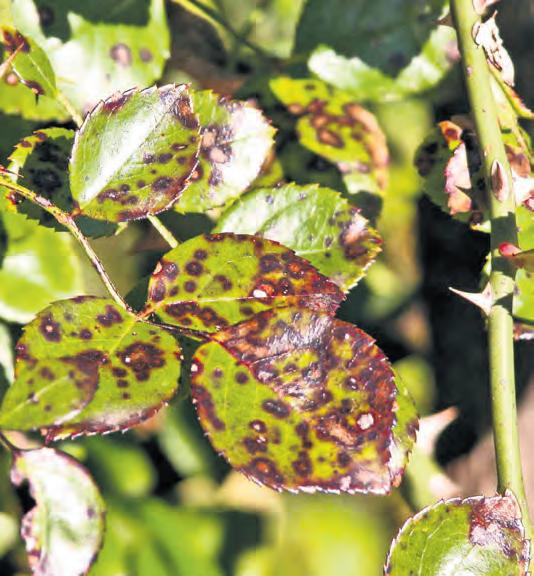
Every year for the past three years my roses have been severely affected by rust and black spot. I have tried feeding, drastic pruning, replacing the soil and even moving one of them. It doesn’t seem to do any good and the leaves are always badly damaged. Is it time to give up?
Kate Rawlinson Dartmouth
There is hope that you can eliminate these problems. There are several reasons why your roses may be suffering from rust or blackspot issues. They could continually be reinfected from neighbouring gardens with diseased roses, or maybe poor hygiene in your own garden has led to the soil underneath the rose to become infected with diseased spores. It sounds as if you have tried several things. Black spot disease spreads primarily through water droplets. Control of rose rust is difficult once symptoms develop. Prune out affected canes and remove leaves as symptoms develop to prevent the spread of rust fungi to other rose shrubs. Destroy these materials by burning. Also, you could try a solution of baking soda sprayed on to the leaves.
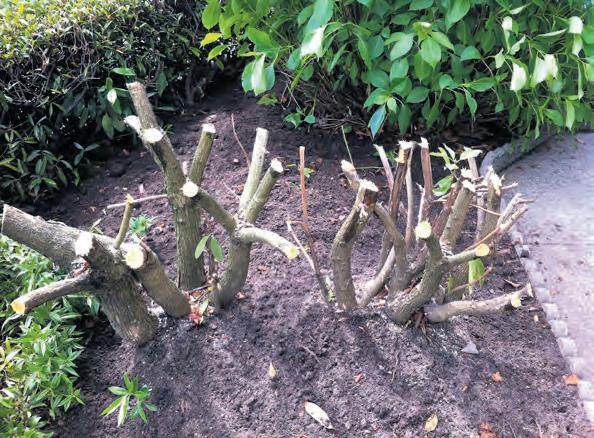
However, after such deep pruning, don’t expect it to bloom for two to three years.
The ideal time to undertake rejuvenation pruning is not after flowering, that’s when you do light pruning, but early in the spring, before the start of the growing season. Cut all the branches to two feet high.
In the first year, your shrub will start to regrow, producing new stems and leaves, but will probably appear very spindly and unequal at first. It will probably take three years before it really fills in and starts to look good again.
How should I overwinter aeoniums? I have half a dozen of them, some indoor and some in pots on the patio.
Alison Hancock Exmouth
For those who don’t know them aeoniums are fleshy, succulent house plants native to Madeira and North Africa. They are very popular, and members of the Crassulaceae family, with rosettes of glossy, waxy leaves and range in height from a few centimetres to up to a metre. Keeping them over winter should be straightforward. Aeoniums are actively growing in autumn and spring, so reduce watering in summer and winter. If you’re keeping your aeoniums outside, they should get all the water they need from rainfall so don’t overwater. You can feed with a half strength plant food once a month from winter to late spring. Aeoniums cannot cope with frost but they can cope with low winter temperatures as long as their compost is not wet – try not to let them go lower than 5°C.
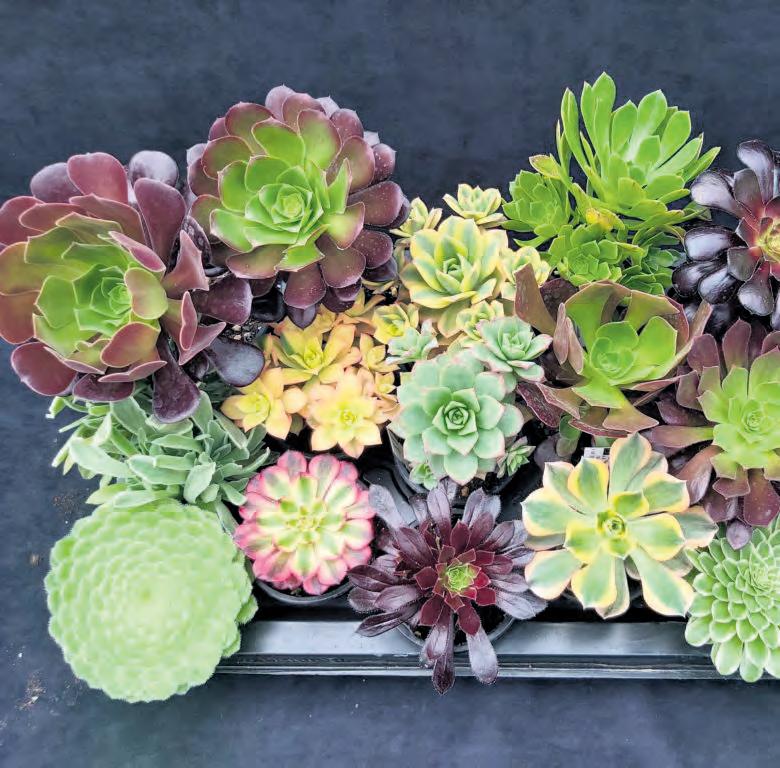

I have been reading that houseplants will naturally remove toxins from the air, especially those in closed rooms with minimal air flow. This is exactly my home. Can you recommend some plants for me to try?
Pat Young Plymouth
Research does now show some house plants naturally remove toxins from the air. The more of these plants you grow, the greater their effects will be.
One of the easiest indoor plants to grow is the peace lily which will tolerate low light but will produce more flowers if placed in a sunnier spot. It is a plant that has been found to cleanse some harmful gases from the air.
Also try the snake plant. This is amongst the easiest of houseplants to grow as well as one of the best airpurifying plants. As a succulent plant with relatively fleshy leaves, it doesn’t need much watering - and is relatively easy to propagate, meaning you can add to your number of plants.

I have tried over two summers to grow a mini wildflower meadow. It has failed badly each time. I thought I followed the instructions on the seed packet but clearly was doing something wrong!
Ann Graham Poole
You really need to abandon many basic gardening principles when it comes to sowing wildflowers. The quality of the soil is perhaps the most obvious one. Most attempts to grow wildflowers fail because the soil is too good. When you have your patch don’t be tempted to enrich the soil, manure or fertiliser will encourage grasses to grow and swamp the flowers. Sow in autumn, giving the seed time to settle in over winter. If you are on heavy clay, however, it is better to wait until spring. Even large areas can be sown by hand quite easily. Ensure that the seed is scattered evenly by sowing half lengthways and the remaining half widthways across the plot. Mixing the seed with silver sand makes the process easier. Rake in lightly and water thoroughly.

I have a climbing honeysuckle that has grown out of control on my archway. Can I cut it back, how much and when is a good time to do it?
Nicky Porter Ilminster
Honeysuckle pruning depends on the type of honeysuckle you are growingclimbing or shrubby. Those that flower early in the summer should be pruned after flowering. Cut back by about one third to maintain a neat shape. Don’t remove the dying flowerheads as these will become berries. Those that flower later in the summer should be pruned lightly in spring. These flower on the current season’s growth, so don’t cut back too hard or you’ll risk losing the flowers.
If your climbing honeysuckle is overgrown, renovate it in late winter by cutting it back hard.
Deciduous shrubby honeysuckles can be pruned after flowering in late spring or summer. If your plant is very overgrown, you can cut it back hard in late winter or early spring.
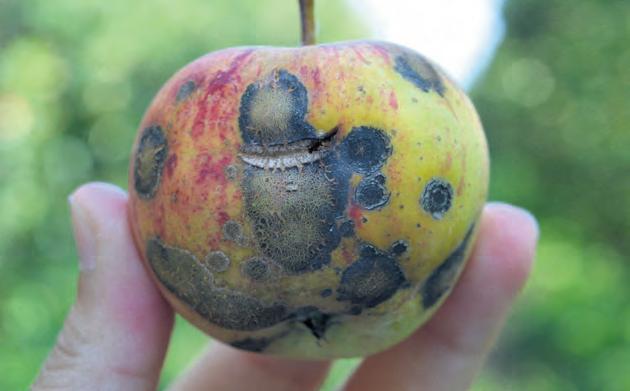
My three crab apples – wonderful source for my crab apple jelly - have been looking ill and damaged for 18 months now. The fruit looks diseased, and I am not sure what the problem is.
Harriet Young Torquay
It is almost certainly apple scab - a fungal disease that causes light green scabs to develop on the leaves and fruit of the tree. These scabs turn darker over time. Apple scab is most likely to develop in warm, moist environments, such as when the tree receives too much water from rain or irrigation. Avoid overwatering the tree and apply an organic spray if the tree is already infected. You should also prune off any infected fruit and limbs to stop the spread of the fungus.
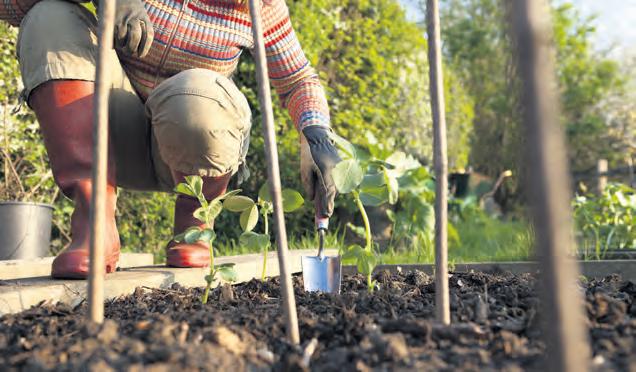
The nights may be drawing in, but there’s still things you can sow and grow at this time of year. We look at what you can safely and successfully plant in November. It can be tempting to start hibernating this time of year!
Too many gardeners write off November as a month where all the activity is focussed on tidying, pruning and clearing. Far from it.
November is a much-maligned month in the garden where there’s still the opportunity to get things in the ground.
Broad beans can be sown in the ground in November. Choose a sunny, sheltered spot with well-drained soil. If your soil is wet give it the chance to dry out, perhaps covering it in plastic for a couple of weeks .
When you sow in late autumn, your beans are unlikely to need watering or weeding. You can look forward to them maturing and being ready to harvest in spring, variety depending.
Garlic is good to plant in November and even into December as it benefits from an initial period of cold. Look for autumn-planting varieties. Plant the bulbs in fertile soil, then mulch. You can also grow garlic in pots.
Garlic doesn’t like to sit in water. If your soil is heavy and wet, you could put an inch of sand or grit in the planting hole before adding the clove and covering with compost. Garlic needs little maintenance. Just water in dry spells and weed when needed. Other than that, wait patiently until harvest time in summer.
Spinach is a crop that produces all year round. Just cut what you need and it grows again. It’s generally best to sow spinach seeds straight into their final growing spot. Transplanting or potting on spinach seedlings can be quite challenging.
You can also grow perpetual spinach in November. Despite the name and how much it looks and tastes like spinach, it’s a type of chard. Regular harvesting of your perpetual spinach will keep it cropping well into spring.
Mild days in late autumn or early winter are a good time to plant raspberry canes. You can find summer or autumn fruiting varieties. Autumn fruiting varieties are typically a bit easier to grow, as the sturdy canes do not need staking. You can grow both but try not to plant them right next to each other – you may get confused about which needs pruning and when!
Choose an open, sunny spot with free draining soil. Before planting, give the roots a good soak in water.
November is a great month for planting bare-root fruit trees. Apples, cherries, pears and plums are just some of the many possibilities. Mid-autumn through to early spring is a great time to plant bare-root trees and hedging plants. The plants have time to establish before the growing season the following spring. See more over the page.
There are some bulbs that are still happy to be planted in November: Tulips (November is one of the best months for these) and there’s till time to plant daffodils. You can also plant bulbs like amaryllis and hyacinth indoors. It is probably too late now for them to flower for Christmas, but you should still be able to enjoy winter blooms. Don’t
There’s nothing more satisfying than planting a tree and watching it grow over the years.
Whether it’s an ornamental tree for the patio, a more substantial traditional tree for the garden or fruit tree for the orchard, getting a tree in the ground is a rewarding task. Buying and planting is best done between November and March. Bare-root and root-balled trees are only available in autumn and early winter and they should be planted immediately.
There is no wrong month for getting your tree in the ground but November is possibly the best.
Planting then can give your tree a head start by allowing its roots to establish themselves before new leaves appear. The ground is normally moist so additional watering may not be necessary.
Planting in colder temperatures in autumn reduces water loss from the tree’s foliage and new bark. It also avoids summer temperatures which can stress new plants, especially if they don’t get much rain. With woody plants like trees, hedge plants, or rose bushes, it’s always better to buy them bareroot.
Bareroot plants are delivered during the winter planting season, from November to March.
Remember: Always check the label on the tree before buying to make sure it will thrive in the spot where you plan to plant it . And don’t forget trees grow, often substantially, so factor in the size the tree will reach in five or ten year’s time.
Adam’s Apples nursery in East Devon grow the largest range of fruit trees in the west country.
This includes over 200 apple varieties, plums, gage, pears, cherries, damson, quince and medlar, all on a range of root stocks to suit your needs. They also sell bare rooted soft fruit plants.
Adam’s Apples are passionate and award-winning cider makers too, and grow and sell some of the best traditional cider apple trees from Devon, Cornwall, Somerset and Herefordshire.
All the trees and bushes are sold bare rooted, available from late autumn through to spring.
Bare rooted trees are cheaper to purchase and easier to transport than potted trees and are the quickest way for trees to establish and thrive.
They are always happy to offer advice and recommendations for your garden, small holding, farm or community orchard and can deliver trees throughout the U.K.
Adam’s Apples Nursery, Dulford, Cullompton EX15 2GA Tel: 07521 648502 sales@adamsappletrees.co.uk www.adamsappletrees.co.uk
Walcot Organic Nursery, located in the Vale of Evesham, will be supplying all sorts of fruit trees over the winter months. Grown in the soil, they are available bare rooted when dormant until late March – natures time for tree planting.
You can choose from a wide selection of organically-grown apples, pears, quinces, plums, damsons and more. Plant, then with a little training, look forward to enjoying delicious fruit in the future!
With Christmas in mind, or at any other time, why not encourage others around you to plant some fruitful trees with a gift voucher?
Orders may be made via the website www.walcotnursery.co.uk, over the phone 01905 841587 or in person. The website provides much advice on choosing and growing fruit trees. A paper catalogue is also available.
Walcot Organic Nursery Ltd, Walcot Lane, Drakes Broughton, Pershore WR10 2AL














Really Useful Plants in Starcross ,Devon, grow 30 varieties of willow for ornamental and wildlife value, living structures, basketry, and craft.
Colourful, ornamental willows make great statement shrubs and wonderful winter interest in gardens. From greens and yellows to bright reds and purples, orange even curly, there are so many attractive variations which can be used for floristry, craft, and basketry.
Robust varieties are excellent for creating willow structures in gardens or community spaces. Vigorous and thicker growing willows make effective windbreaks and hedges.
Willows are beneficial for wildlife with early spring catkins a source of food for pollinators. They also improve soils, can be used as a rooting hormone, dye plant, and have medicinal properties!
Willows can be planted as cuttings/rods in the winter making growing willows very simple. Willow planting advice offered and commissions for sculptures and workshops available.
For willow sales, commissions & willow workshops. reallyusefulplants@outlook.com www.reallyusefulplants.co.uk






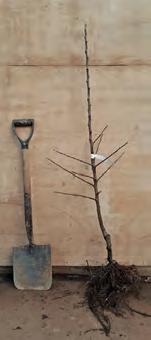
Bare Rooted Fruit Trees
Traditional & heritage varieties
Rooted Fruit Trees Traditional &
in Devon
Bulk discounts available UK delivery
Tel. 07521 648 502 sales@adamsappletrees.co.uk adamsappletrees.co.uk
Tel. 07521 648 502 sales@adamsappletrees.co.uk adamsappletrees.co.uk

Want to advertise in one of our features?
We offer special all counties prices when advertising with our features, plus 100 words of free editorial with an advert.
Speak to one of our sales people for more details.
Easy to grow and a real bonus in the kitchen, rhubarb also has the advantage of being one of the first crops of spring.
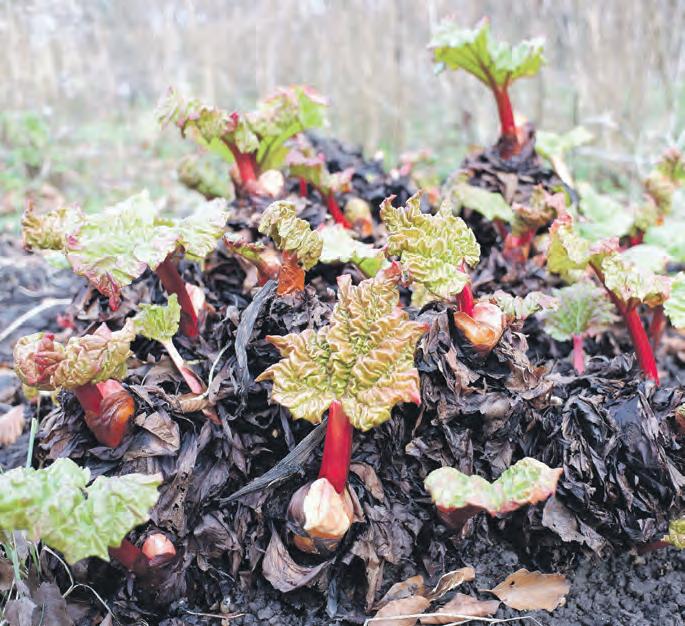

There was a time when rhubarb could be found growing in almost every vegetable garden. Thankfully in the last ten or so years rhubarb has made an impressive return to its former glory days.
If you aren’t already growing it, give rhubarb a try! Rhubarb is a perennial plant that will live for years in a garden. It has the botanical name Rheum x hybridum, because most varieties today are hybrids grown for centuries.
The plant is a heavy feeder and needs to be planted in soil high in organic matter if you want to have large, thick rhubarb stalks. It helps the plant to cultivate around it, and to keep it mulched, weed-free, and well-watered.
The plant also likes a neutral pH soil. Many gardening books and gardeners recommend putting wood ashes in a ring around the plants in the spring.
Rhubarb needs a soil that is both fertile and freedraining, as the crowns will rot if left to sit in cold, wet soil so dig in lots of compost or well-rotted farmyard manure a few weeks before planting. Rhubarb is usually grown from crowns.
These are young plants, between one to two years old, that look like bundles of tuberous roots, topped by a few buds.
The best time to plant rhubarb is in late autumn or early winter when the plant is dormant, although it can also be planted in early spring.
Clear the area of all weeds and stones. Plant the rhubarb crowns three feet apart with four feet between rows. Plant the crowns with their buds just below the surface of the soil.
Feed the plants with a balanced fertiliser in spring and water regularly in dry spells.
Deadhead any flowers as soon as they appear, to focus all the plants’ energy into producing stems and leaves.
Once the foliage has died back in autumn, cut off all old leaves and compost them. Provided the soil is well-drained, the plants will not be harmed by cold winter weather. In fact, the crowns need a period of temperatures below 3ºC to stimulate new growth in spring.
Mulch around the plants in autumn with a thick layer of organic compost or well-rotted farmyard manure. Take care not to bury the crowns when mulching, or they may rot.
Rhubarb plants need to be divided every five to six years to rejuvenate them. In winter, when the plants are dormant, dig up any crowns that need to be divided. Using the sharp edge of a spade, cut the crowns into three or four separate segments, making sure each segment has at least one bud. Replant each segment as a new plant.
Forcing rhubarb is a technique used by gardeners to obtain getting an early rhubarb harvest. It was strangely enough discovered by accident at the Chelsea Physic Gardens in the early 19th century,
The forcing process simply involves excluding all light from the plants.
This stimulates them to grow, producing pale, tender stems with a delicate flavour that can be harvested around two to three weeks before the normal crop.
In mid to late winter, select the crowns want to force and cover them with straw, then place large containers over these crowns to block out all light. You can buy purpose-made rhubarb forcing pots, but an upturned bucket or dustbin works

‘Force’ rhubarb to get an even earlier crop
equally well. When the stems reach the tip of the container, they are ready to harvest.
Forcing rhubarb weakens the plant, so only force established plants, and don’t force the same plant two years running.
Harvesting rhubarb does require a little patience especially with new plantings.
To give new plants a chance to establish themselves well, don’t harvest any rhubarb in the first year after planting. In the second year, you can harvest a few stems from each plant, but make sure to leave at least three or four strong stems on the plant.
In the following years, you can harvest up to half of the stems on each plant and you will find it fast growing and rampant.
Harvest from mid-spring when the stems have a good colour and the leaves are fully unfurled. Don’t cut the stems to harvest them, just hold them at the base and pull firmly to detach them from the crown.
Stop harvesting rhubarb after mid-June to give the plants a chance to build up their reserves again for next year’s crop.
Rhubarb leaves are toxic so don’t cook or eat them. Cut them off the harvested stems and either throw them away or you can safely compost them.
There are many different varieties of rhubarb available, but here are a few popular types of rhubarb:
• Rhubarb ‘Glaskin’s Perpetual’: a late-cropping variety producing large, juicy pink- and green-streaked stems with a sweet flavour.
• Rhubarb ‘Hawkes Champagne’ AGM: a compact, high-yielding variety, producing bright red stems with a sweet taste.
• Rhubarb ‘Timperley Early’ AGM: bred especially for indoor forcing, this variety also grows well unforced, producing an early harvest of pink stems streaked with green.
• Rhubarb ‘Victoria’: one of the oldest varieties but still popular, producing a heavy crop of pink-tinged green stems with a good balance of sweetness and acidity.
Once soil temperatures drop below eight degrees, biological activity in the soil slows.
So, during winter months, it needs a little help.

It is obvious that the secret to gardening lies in the quality of our soil. We demand a lot of it during the growing season so come the winter months it needs our help- and badly. It is about to get battered by months of rain, wind, frost, sometimes snow but there is a basic plan we can all put into operation to help it through to spring.

You must test your soil. It’s the first rule of gardening. It is vital you know what type of soil you’ve got in your garden: clay, silt, sandy, chalky or loam. Knowing the type will help you choose the right plants for your garden and figure out what care it needs specially over the winter months. There are some simple tests but they are not precise and inadequate Grab a handful of soil and squeeze it. If it falls to pieces,
you have a sandy soil, if you can mould it like plasticine, you have a clay soil, while loam is intermediate.
To dig deeper into the health of your soil this winter, you should buy a simple soil test kit available from all gardening ships and garden centres
Mulches are a covering of biodegradable material. They provide a natural blanket which protects the soil from erosion by harsh winds and water. It will also suppress weeds and deter garden pests.Leaves, wood chips, sawdust, straw and compost make excellent mulches and are easy to apply. Spread these organic materials on the soil surface around your plants, creating ideally a four inch - but make sure you don’t cover the plants. Remember to take the mulch off a couple of weeks before planting, so the sun can warm up the soil, making it ready for plant growth.

• Healthy soils have six different layers which are known as horizons. the top level is organic matter- a build-up of plant and animal residues. At the bottom is solid bedrock.
• One gram of soil (a quarter of a tablespoon) can harbour up to 10 billion organisms - that’s more than the number of people living on the planet!
• There is still much more we can learn about the soil. Only about 1 per-cent of the microorganisms found in soil have been identified - our soils are one of the largest reservoirs of microbial diversity on Earth.
• A total of per-cent of food production relies on the soil – healthy topsoil is vital to our existence, but we are losing topsoil at an alarming rate - between 10 and 40 times faster than it’s formed.
• Soils store more carbon than the atmosphere, and all the world’s plants and forests combined, which means that soil is one of our most important weapons in the fight against climate change.
Cover crops or green manures are quick-growing plants keep soil covered over winter, protecting it from erosion. They also retain and recycle plant nutrients, add organic matter to the soil and really do improve soil structure. Cold-hardy options like hairy vetch and cereal rye could add nitrogen to your soil, suppress weeds, and attract wildlife.
Dandelions, bittercress, chickweeds, and other winter weeds are used as natural winter cover. They protect soil from erosion and improve its drainage.
Heap any beds that will remain empty over winter with compost and cover them with an old blanket or cloth or cardboard. This will control how much moisture seeps into the soil and reduces compaction from rainfall, so your soil retains its good structure.
Remove the cover in spring to let the compost breathe in the air for a few days and then dig the nutrient-rich mixture through – your soil will thank you.
Dandelions, bittercress, chickweeds, and other winter weeds are used as natural winter cover. They protect soil from erosion and improve its drainage. Although useful, winter weeds can quickly take over your garden so you do need to control them. These include hoeing, forking them out or applying a thick layer of mulch.
• Healthy soil can help to prevent floods and mitigate the effects of drought - soils can store one and a half Olympic swimming pools full of water per hectare.
• Earthworms are the real heroes of healthy soils. Their activity offers many benefits, from increased nutrient availability and better drainage, to creating a more stable soil structure. You can find more earthworms in the soils on organic farms.
• Every minute we lose the equivalent of 30 football pitches of fertile soil. When we don’t look after it, soil can lose its ability to support plant growth, become contaminated or erode, and it can take up to 1,000 thousand years for a single centimetre of topsoil to form.
• Organic gardens have 20 per-cent more organic matter in their soil on average. They make soil health a key priority on their farms, building fertility naturally using compost, crop rotation and nitrogen-fixing crops. Organic farmers use, on average, 65per cent more compost on their farms! Organic matter is important for building healthy, fertile soils, and helping the soil to hold and store water.
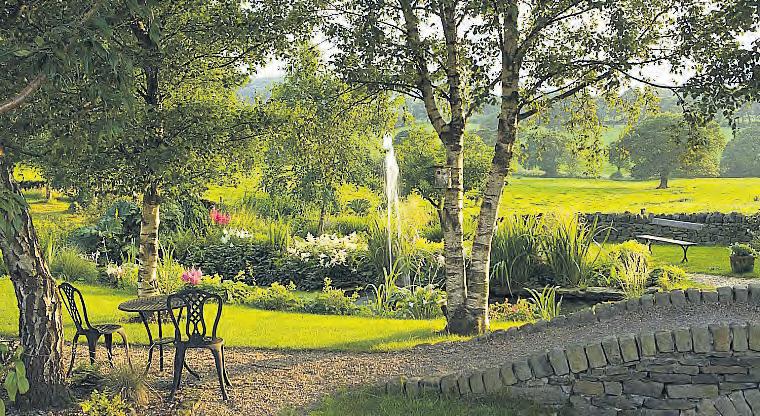
Mary Harding wanted a break from dealing with some very sad news, so took herself off a on a road trip visiting private gardens open for the NGS and found the effect made a real difference to her state of mind.
I am I think quite exhausted but content.
I have just finished a two-week spell when I visited seven National Garden Scheme open gardens all in Devon, Somerset or Dorset. I wanted to get away from home and all the things I had to do so September seemed a great time to do this.


In August I lost both my parents within three weeks of each other and the effect on me was devastating. They were old and had been ill for some time, but nothing really prepares you for it.
I am a passionate gardener and I have in my garden notebook a list of the NGS gardens I would like to visit but never really got round to it. Well in September I finally did.
The NGS has always claimed that visiting a private garden is good for the soul. I think they have research that it has a positive impact on their mental wellbeing and eight out of ten feel happier after visiting than before.
I certainly did.
The owners of gardens which open for the NGS are a remarkable bunch and I can now talk with experience. They are friendly, proud of their gardens, keen to share their love of gardening and engage in conversations of how they planted this plant, what happened to that plant, how much it all costs and how many people have visited. They are a quite competitive lot.
The effect on my state of mind was interesting, I guess. I felt more relaxed and peaceful being in the gardens and less stressed, sad and bored.
The idea came from my GP (and friend I should add) who was concerned I was getting bogged down in the detail of funerals, wills, spreading the word of my parents’ deaths and it was having a bad effect on me.
I couldn’t sleep and eating even became something which was more of a chore than a pleasure.
She suggested a break and together we came up with this idea of a road trip visiting gardens and spending time with gardeners and with nature.
I would recommend it to anyone who wants to do something different. I don’t believe it is a seasonal thing either. I plan some October and November visits.
I think research generally links the health benefits of garden visiting to the summer months when most gardens are at their abundant best. But now there’s a strong view which highlights the benefits of visiting in winter and, as well as comparing those to visiting in summer, shows how a winter visit helps combat the seasonal challenges that we all face at that time of year.
It all boils down to what we gardeners all probably know but perhaps don’t follow through on, which is that being in a garden is very good for you. It certainly has lifted my spirits and left me feeling I can cope more.



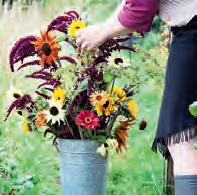





Secluded cosy cabins & lodges in wooded valley running down to Wembury Bay & SW Coastal Path
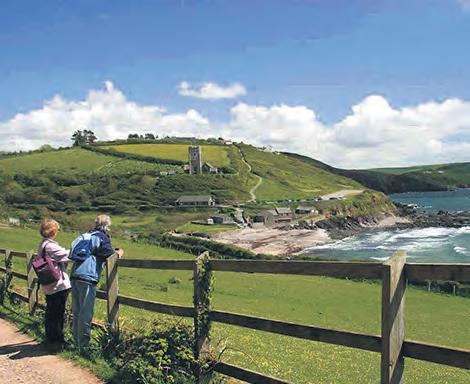
Plymouth, Dartmoor & lovely South Devon Villages & Towns in easy reach. Pets Welcome. Forest School. Tel: 01752 862382 www.churchwoodvalley.com

Carmarthen Bay South Wales
Seafront chalet situated on estuary. Sleeps up to 6. Seaview. Well Behaved Dogs Welcome Free of Charge. Free WIFI. Open from 1st March - 31st Dec. For Brochure
Tel: 01269 862191
BOSWORLAS, ST JUST. Cosy Cottage sleeps 2-4. Please email info@bosworlas.co.uk for availability
GLORIOUS NORTH DEVON. Only 9 cosy caravans on peaceful farm. Wonderful walks in woods & meadows. Easy reach sea, moors & lovely days out. £125-395pw. Discount couples. Nice pets welcome. 01769 540366 www.snapdown.co.uk
ACCOMMODATION HOLIDAY COTTAGES
WYE VALLEY/FOREST OF DEAN. Fully equipped single-storey cottage with two en-suite bedrooms. Wi-fi.Recently awarded Visit England 4-star GOLD. Rural retreat, shops/pubs one mile. Enquiries welcome. AS SEEN ON ESCAPE TO THE COUNTRY! Tel: 01594 833259 www.cowshedcottage.co.uk
ACCOMMODATION WITH BEAUTIFUL GARDENS


Mill House Fine Art Publishing, Bellflower Gallery, Market Place, Colyton, Devon EX24 6JS Tel. 01297 553100 info@millhousefineart.com www.millhousefineart.com


jonne@jonne.co.uk 07770 720 373
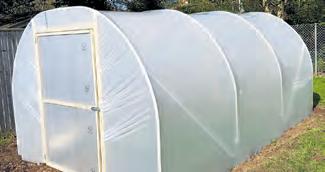

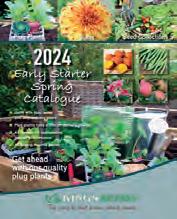

Near Stratford-upon-Avon
cottage in
large
Sleeps 2. Perfect for famous gardens, NT properties & Cotswolds. Tel: 01789 740360 www.romanacres.com
NORTH DEVON NEAR CLOVELLY. 3 delightful cottages situated in 12 acres of idyllic countryside. Sleeps 2-4. 1 Wheelchair friendly. Brochure: 01237 431324 www.foxwoodlodge.co.uk foxwoodlodge@outlook.com
Editorial Publisher & Editor: Alan Lewis
alan@countrygardener.co.uk
Tel: 01823 431767
Time Off
Kate Lewis timeoff@countrygardener.co.uk
Advertising Sales
www.thegardenersblacksmith.co.uk Want this space?
ADVERTISE HERE
Email: classified@countrygardener.co.uk
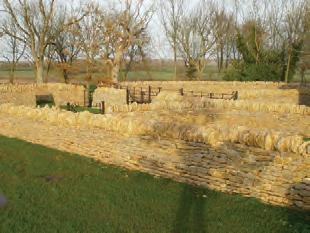
Yenstone Walling Dry Stone Walling and Landscaping
Patrick Houchen - DSWA member Tel: 01963 371123 www.yenstonewalling.co.uk
Ava Bench - Somerset & Hampshire
ava@countrygardener.co.uk
Tel: 01278 786139
Cath Pettyfer - Devon cath.pettyfer@countrygardener.co.uk Tel: 01837 82660


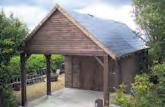

Corina Reay - Cotswolds & Dorset corina@countrygardener.co.uk Tel: 01823 410098
Classifieds classified@countrygardener.co.uk
Accounts and subscriptions
Heather Rose heather@countrygardener.co.uk

Design & Production
Aidan Gill
aidan@countrygardener.co.uk
Gemma Stringer gemma@countrygardener.co.uk
Distribution & Stockists distribution@countrygardener.co.uk
Autumn and into November can be brutal, with the unpredictable weather and extreme conditions it can be difficult to prepare our gardens for the looming weather. Not only plants suffer, wildlife struggles during deteriorating weather. Garden wildlife expert Lucy Taylor explains how to prepare gardens to support wildlife.
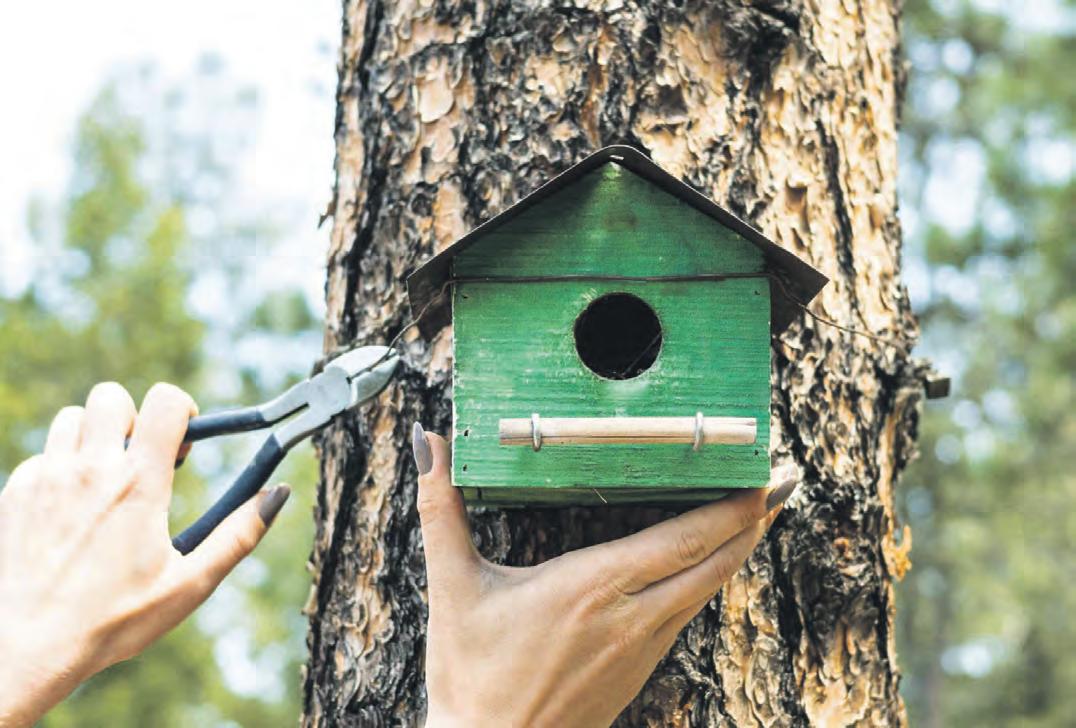
Now is the time to consider how you can help take care of wildlife in gardens in the colder months ahead. Garden wildlife expert Lucy Taylor has set out some best practice for what is to come.
“Wherever you live in the UK, it’s unlikely that the summer this year has been a particularly good one. But we hopefully still have the odd week for the sun to shine warmly on our gardens, and during this time it’s a great opportunity to plan some important tasks that can be carried out during autumn to help wildlife get through the winter. That said, one real benefit of a garden which very much has wildlife in mind, is that it can mean less work and less specific tasks compared to a neat-and-tidy and more traditional garden – which will become apparent in some of these examples.”
We’ve long had a bit of an obsession in the UK for clearing up fallen leaves in our gardens and then disposing of them, but attitudes are changing and it’s much better to see autumn leaves as something of a harvest. In the same way that invertebrates use the dead foliage of the perennial plants for protection and food, the same is true for leaves. So create piles of leaves in the corners of your garden, spread them onto borders, or, with the exceptions of paths and patios, just let them remain where they’ve fallen.
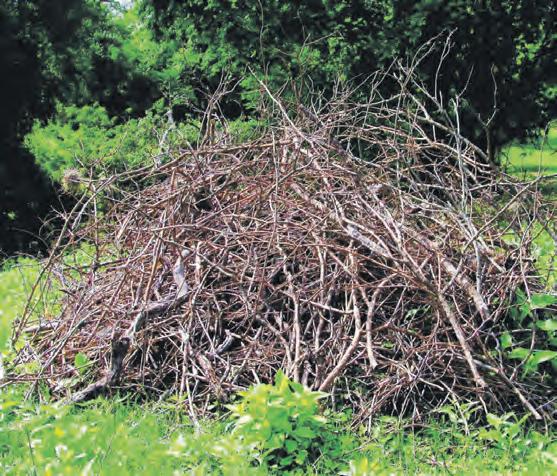
A habitat pile is typically a mound of branches, twigs, old plants, hedge trimmings and other garden materials, which can be any size and shape – though ideally aim to get some height in it and up to one metre or so. Habitat piles benefit wildlife in a number of ways, with an important one being somewhere to shelter or even hibernate for small mammals, including hedgehogs, plus amphibians like frogs and toads. Insects and spiders will also hide within the structure, with these then becoming food for small songbirds and notably wrens. A small pile of logs can support a multitude of different insects, provide a refuge and hunting ground for small mammals, reptiles and amphibians, and shelter for over-wintering and hibernating wildlife.
Apart from the habitats created by the untidy flower border or hedge bottom, it is possible to create additional overwintering sites specifically to attract wildlife. Choose an area which is rarely used, or some inaccessible spot which can remain undisturbed for years if necessary. This rough corner should be well away from public areas, so that disturbance is kept to a minimum. A pile of logs or old timber will soon be covered in fungi and offer shelter to hedgehogs, wood mice, wrens and possibly foxes.
A pile of rocks, stones or old paving slabs will harbour insects, possibly slow worms and offer shelter to hibernating frogs and toads.
Loosely piled grass clippings or straw will house insects and ground feeding birds. They may also attract field mice and shrews.
Along with ensuring that birds such as blue tits have somewhere to nest come the early spring, putting up nest boxes now gives several different species somewhere to safely spend the long cold nights. The height from the ground should be about three metres — small-hole boxes are best placed 1-3m above ground on tree trunks, but avoid sites where foliage obscures the entrance hole - a clear flight path is important. If there are no trees in your garden, the next best option is to place your box on the side of a shed or wall. The recommended direction to face a nest box is between the north and east as this will provide natural protection from direct sunlight, wind and rain, creating a more suitable and safe environment for growing birds. The box can also be tilted marginally forward to allow any rain to run clear of the entrance.
Whilst you might want to trim longer stems off and those with dead flower heads during the autumn, leaving perennial plants in beds and pots to rot down naturally during the winter months has a great benefit to wildlife – and also helps enrich soil. The benefit to wildlife comes from the fact that the ground immediately below the rotting vegetation is at least partly protected from frost, with this allowing invertebrates such as insects to shelter or hibernate, which in turn become food for birds. Worms will also remain closer to the surface of the protected ground as they consume the rotting vegetation, which then also makes them food for birds, including robins and blackbirds.
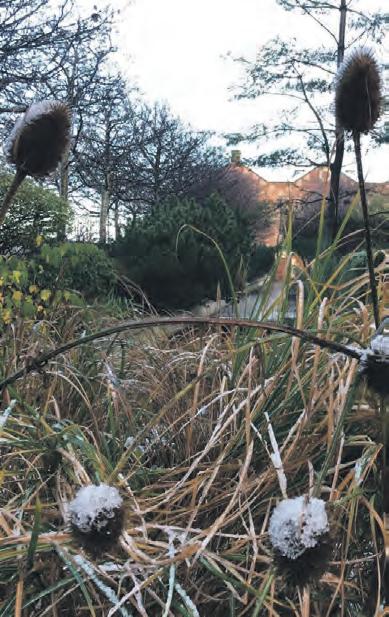
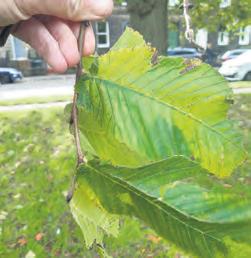

Mark Hinsley does some detective work on a rare tree - a variety of elm once well known in Dorset then exported to the USA which fell victim here to Dutch elm disease which may soon be back home.
If any of my readers remain at liberty, they may remember four or years ago I brought you news of a rare tree, Sorbus domestica, the True Service Tree, growing in Blandford, Dorset.
Today I have more news from that horticultural hotbed; this time of a rare tree not in Blandford but of Blandford.
The Blandford elm – Ulmus glabra ‘Superba’.
On September the 13th 1845 the following was published by John Lindley (1799-1865) the editor of The Gardeners Chronicle on page 628:
‘The elm – we have measured the leaves of Mr Gill’s new elm; ten inches long and six inches wide. If the tree continues when old to bear such leaves it will be a very remarkable variety. It belongs to the species called by botanists Ulmus montana, the Witch Elm.
The botanical name for the tree these days is Ulmus glabra ‘Superba’.
The common name is the Blandford elm. It is a variety of Wych elm – nothing to do with witches, who apparently shun elm trees – but a reference to how bendy the timber is from the Old English ‘wice’ meaning pliable.
There was an ancient wych elm that stood on the boundary between Dorset and Wiltshire called the Larmer Tree, replaced now with an oak. But this will have been the straight species, not the ‘superba’ variety. We know that the Blandford elm was exported to the East Coast of America. Records of it in Boston, New York and Washington DC exist. It appears under different names; some nursery catalogues call it the ‘Belgian elm’, because it was exported first to Belgium and then on to America. It shows up as both a variety of montana, x hollandica and glabra.
We are delighted to be able to give publicity with event details and contacts for gardening clubs events/outings/meetings. Take advantage of our free service. If you have your programme of events organized for 2025 then let us have them in full now and we can allocate month by month throughout next year. Send your information to timeoff@countrygardener.co.uk

21ST
Meavy Garden Society
‘CAMELLIAS’ - JEREMY WILSON Details on 01822 852672 22ND
Crediton Garden Club
‘GERTRUDE JEKYLL - GARDEN DESIGNER’ - DAVID USHER 24TH
WARNING! Somewhere there is a darkened room containing wide eyed, dribbling individuals carefully wrapped in straight jackets so they cannot harm themselves or each other. These gentle reader, are the unfortunate souls who have tried to understand and unpick the genus ulmus. You delve into this at your peril.
Blandford elms were recorded growing in Kew Gardens. Wych elms do not produce suckers, so, unlike their cousins Ulmus procera the English elm, they have not been able to constantly throw up new growth from old root systems. On the other hand, they are not all linked together by disease spreading root grafts, so some have survived, and we do occasionally come across them here in the south.
In Scotland and the North-East of England Wych elm has fared better still. For several factors, day length, temperature and biological competition included, the disease has not spread so virulently, but it is there, and it is killing trees.
However, in Leith Links Gardens in Edinburgh, a Blandford elm survives!
On behalf of the good burghers of Blandford, I have been in touch with Ross Woodside of Edinburgh & Lothians Greenspace Trust. Ross has kindly confirmed the existence of the tree and sent us some photos.
As a variety the Blandford elm will not breed true from seed. Wych elm is known to root from layers. Air layering may be a possibility – this involves wrapping a small stem with some bound-on compost to encourage it to root. When it does it is pruned out below the roots, and you have a new tree. The other possibility is cuttings. To do any of this we are going to need local help and the cooperation of the council who own the tree – so that will be the next step to bring the Blandford elm home.
Mark Hinsley, of Mark Hinsley Arboricultural Consultants Ltd, offering tree consultancy services. www.treeadvice.info
North Dartmoor Garden Club ‘CREATING A DIVERSE AND RESILIENT GARDEN WITH PERENNIAL VEGETABLES’ - MANDY BARBER Email: watsongp@hotmail.com 31ST
Budleigh Salterton Garden Club ‘GARDENS AND PLANTS OF MADEIRA’ - SAUL WALKER Details on 01395 445840
Exmouth Garden Club ‘NO NETTLES REQUIRED: GARDENING FOR WILDLIFE’ - KEN THOMPSON www.exmouthgardenclub.co.uk
2ND
Hardy Plant Society Devon Group, Longdown Village Hall ‘ROSCOEA - INCLUDING A REPOTTING DEMO’ - HOPES GARDEN PLANTS Email: devon@hardy.plant.org.uk 4TH
Brixham Horticultural Society MONTHLY MEETING Details on 01803 842121
Plympton Gardeners Association ‘PROPAGATION’ - GEORGE KESTELL Details on 01752 336057
South Devon Alpine Garden Society ‘GEORGIA & THE CAUCASUS’ - KURT VICKERY Details on 07940 372940
Teignmouth Gardening Club ‘GARDENING FOR WILDLIFE’ - JOHN WALTERS
Email: nickcooling4@aol.com 11TH
The Clearbrook Horticultural Group ‘TRADITIONAL ENGLISH ORCHARDS’ TALK & DEMONSTRATION BY DAVID CURRY
Details on 01752 776230
12TH
Exminster Gardening Club
‘GROWING VEG IN SMALL SPACES’ Details on 01392 832762
Woodbury Garden Club ‘IMPORTANT TREES IN WOODBURYWHAT TO PLANT IN YOUR GARDEN’ Details on 07470 022039 13TH
Ogwell Garden Society
‘ALIEN INVADERS IN DEVON’ - ROGER AVERY
Details on 01626 364543 18TH
Meavy Garden Society
‘A CHRISTMAS MISCELLANY’ - JOICE REITH & GARDENER’S QUESTION TIME Details on 01822 852672 20TH
Torquay and District Garden Club ‘PUMPKINS ON PARADE’ - LORI REICH Email: nickibaker222@gmail.com 26TH
Crediton Garden Club ‘PLANTS OF THE CANARY ISLANDS’ - BEN CANDLIN
Exmouth Garden Club ‘CLUB AGM, BUFFET SUPPER & GARDEN QUIZ’ www.exmouthgardenclub.co.uk
28TH
Budleigh Salterton Garden Club ‘SUCCULENTS & GINGER LILIES’ - DAMIEN COATES Details on 01395 445840 North Dartmoor Garden Club ‘WEIRD & WONDERFUL IN A DARTMOOR GARDEN’ - ROBIN HILL Email: watsongp@hotmail.com
Are you part of a garden club or society?
Please send us your diary for the year - we’d love to include your talks and shows It's free!
Send them into us by email giving us 10 weeks notice of the event: timeoff@countrygardener.co.uk or by post to: Mount House, Halse, Taunton, TA4 3AD.


